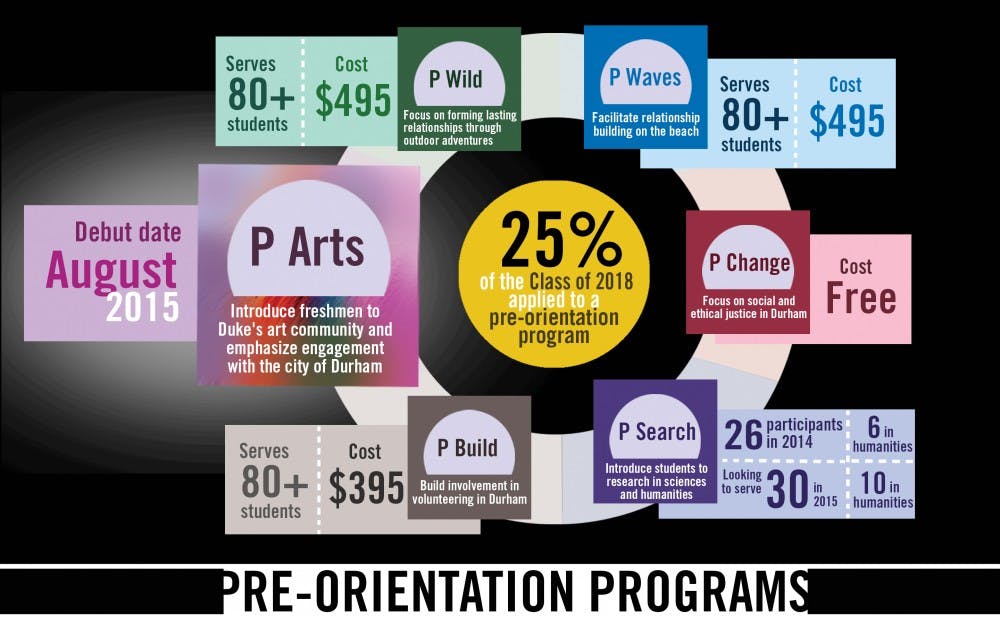Duke's pre-orientation programs can offer a sense of community, connections with upperclassmen and unique adventures—for a select number of students. This year, however, a new program will ensure that more incoming freshmen are able to participate.
Project Arts, set to debut in August 2015, will focus on introducing interested freshmen to Duke's art community and emphasize engagement with the city of Durham. The first new pre-o since 2009, it joins the five programs Duke currently offers—Project Wild, Project Change, Project Build, Project Search and Project Waves.
Sophomore Shelby Wailes, the project's co-leader, said that one of her goals was to increase accessibility of pre-orientation programs—which have grown increasingly selective as interest has increased in recent years.
“The theme we chose: 'Art Activism through Classism' is geared to challenge and introduce art appreciators to the Duke community,” said sophomore Steven Soto, the project's co-leader.
Director of New Student Programs Jordan Hale noted that demand for pre-orientation programs is up—adding that almost a quarter of the Class of 2018 chose to apply.
“The number of applicants continues to rise," Hale said, adding that the trend has been seen for at least the last five years. "Last year we had over 400 applicants.”
The selectivity of programs varies, depending on how many applications each program receives and how many spots are available. PSearch, the smallest program, aims to take 30 students each year, while larger programs such as PWild, PBuild and PWaves serve more than 80 students each.
The application process also differs by program—with some requiring essay responses and others selecting participants randomly.
Senior Connor Moore, who co-led PWaves in 2014, noted that of the 180 students who listed PWaves as their first choice, 80 students were selected due to size constraints.
Project Search, which introduces students to research with faculty in the sciences and humanities, receives fewer applications and is therefore able to be less selective. Because PSearch is among the smaller of the programs, with 26 students participating in 2014, incoming students may not be aware of what the program offers, incoming director Natalie Atyeo, a junior, said.
“One of our biggest tasks is getting students involved and knowing what it is,” she said.
Hale said the size constraints that restrict the number of students each program can take are determined by the program directors.
“The size of each program is decided by the student staff who lead the programs," Hale wrote in an email March 17. "This size is determined by the number of crew in each and the size of the group that will allow participants to have a quality experience."
The only information that student crew leaders for PWaves and PWild receive about incoming freshmen is their name, gender and home state.
This information is used to form crews that are even in gender and contain geographic diversity, said senior Duncan Dodson, a former co-leader for PWild.
Leaders from some of the bigger trips said group dynamics can sometimes pose a challenge that they must work through.
“The crew’s morale is sometimes low when camping out for three nights in the sand and cooking your own food—you really have to stay positive,” Moore said. “On a crew-to-crew basis you really kind of have to feel it out for personality and try to create an environment where everyone feels comfortable.”
Dodson agreed that group dynamics are often tested when embarking on challenging tasks—allowing the students to get to know one another in a unique way.
“I really believe it’s much harder to have a facade when you’re out in the wilderness for two weeks,” he said.
Some students who have participated in PWild echoed Dodson’s sentiment that challenging dynamics helped build lasting friendships.
“Taking part in PWild not only made the transition from high school to college easier due to the large amount of friends I made in the program, but gave me a community to be a part of,” said freshman Matthew Newman, who participated in the program this summer.
Each program provides opportunities for students to remain involved by returning as crew leaders after their freshman year.
Some students, though, expressed disappointment about the limited space and perception of exclusivity surrounding the programs.
“I could easily tell who had done a pre-o program because they certainly seemed to know more people, but I think that was very temporary,” said freshman Rachel Rohde, an avid backpacker who was not selected to participate in PWild.
Other factors that may limit the scope of the programs’ reach include cost and proximity to North Carolina.
Project Change, which focuses on social and ethical justice in Durham, is the only free program. Projects Search, Waves, and Wild cost $495 each, and Project Build costs $395. Leaders Project Arts predicted similar costs for their program.
Hale said he is not able to discuss the budget of the programs.
The financial aid office informs pre-orientation programs of students' general level of financial need—classifying it as low, mid or high, said Alison Rabil, assistant vice provost and director of financial aid. Students identified as high need are able to participate at a discounted rate.
Get The Chronicle straight to your inbox
Signup for our weekly newsletter. Cancel at any time.

